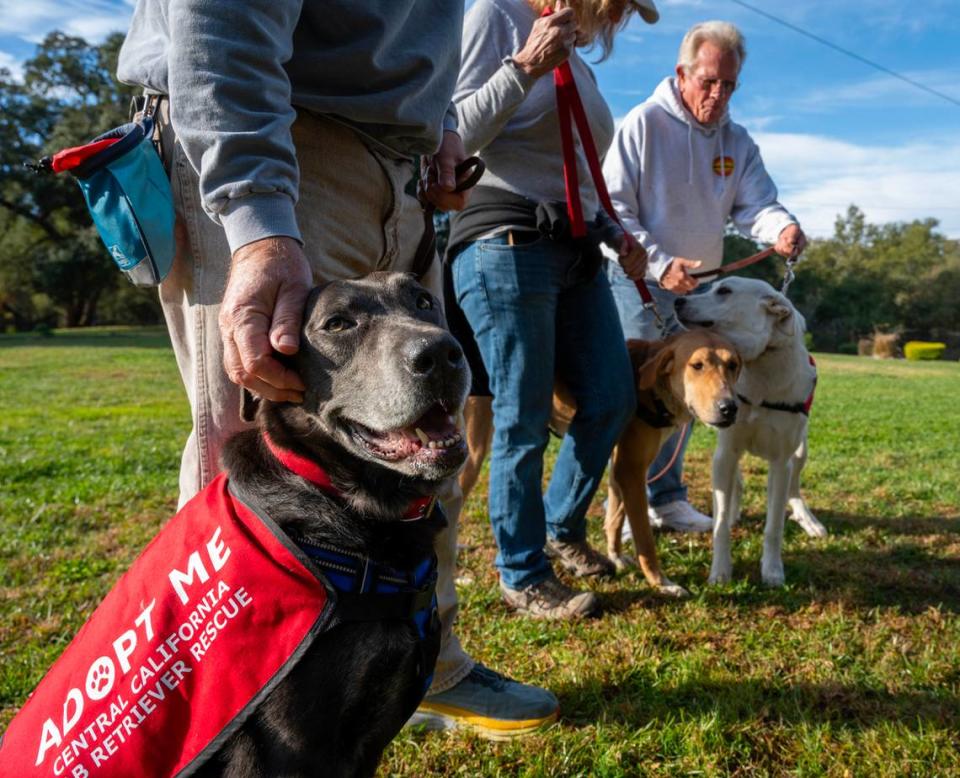Book of Dreams: Help Lab rescue group support these dogs, some abandoned after the pandemic
Looking into his soulful eyes, it’s hard to believe that anyone could have given up Cotton, a cheerful white Lab/Akbash/Pyrenees mix. Or Greer, a lively and sleek yellow Lab beauty, still growing at 18 months. Or white-muzzled Jack, who, even at age 7, springs to high alert at the sound of a squeaky toy.
Yet all were given up by former owners and ended up under the care of Central California Labrador Retriever Rescue, an all-volunteer organization founded in 1998. The group has no central facility or shelter. Instead, it places dogs it rescues in foster homes where they stay and receive training and veterinary help until they are adopted.
This is a group that relies on donations, and this year it is seeking $7,500 from readers of the Sacramento Bee’s Book of Dreams project to further its mission of finding new homes for abandoned dogs.
“We need community support to be able to help these dogs, especially those who are sick and injured,” said the organization’s president, Irena Bolstad.
Cover the vet bills
Last year CCLRR spent nearly $55,000 to rescue and rehome 175 dogs,“ Bolstad said. More than $45,000 of that money was spent on vet care.
The group currently has 75 volunteers who provide dog training or transportation to veterinarians when the foster owners can’t, and although many of the fosters spend their money on the care and feeding of their charges, some are only able to provide their time and love.
CCLRR provides foster owners with peer-to-peer support as they prepare the dogs for adoption, aiding them as they help the dogs through whatever behavioral problems they may have developed during past abuse or just from being in a shelter that wasn’t fully staffed.
Many need medical care. Some rescues have never been to a vet, others have broken bones, tendon tears or sores that were never treated. Some have parvo or other canine diseases.
And the fees for vet services are rising, said the group’s treasurer, Erika Sechrist.
“The cost of shots, drugs, microchip and spay/neuter for each dog averages $500,” Bolstad said. “Adoption fees only cover about half of these costs.”

Meet Bitsy, the ‘tester dog’
Cathy Chance, rescue representative for the group, recently coordinated a meeting of several of the CCLRR’s canine clients and their foster home buddies, along with several “foster fails” — dog lovers who stepped up to foster an abandoned dog and ended up adopting it. The meeting place was a home with a large backyard in Granite Bay.
Sally Hanger, a part of CCLRR almost from the beginning and now “pushing 80,” brought Bitsy, a 13-year-old Lab that she found six years ago at another rescue organization, Labs to Love.
“She’s my tester dog — she’s pretty mellow,” Hanger said of Bitsy, who helps out in dog-to-dog introductions.
“I look at the (new) dog’s posture, note if the hair on its back bristles, any growling,” she said. Then she brings in Bitsy to see how the newcomer gets along with others. “It’s really hard at shelters to evaluate a dog’s personality, especially when you have a hundred dogs barking all at once.”
Hanger had high praise for the group. “It’s a cliché, but it does take a village,” she said. “Some (volunteers) provide transport, others provide guidance, others bring in another dog into their lives.”

Pandemic problems
Chance, Hanger and Sechrist all say the dogs have been coming into the program with more problems sincethe pandemic. Some of the dogs’ previous owners delayed medical care for them during the pandemic and some pets ended up at shelters that were understaffed.
And because the demand for dogs increased while people were working from home, the number of “backyard breeders” (who may not have screened for genetic deformities) also increased.
Those problems “drain a lot of our resources and increase the time needed for fostering before the dogs can be adopted,” Hanger said.
“We need more foster homes,” said Chance. “Some of our most experienced people are aging out, others are wanting to travel more and don’t want to be tied down so much. Some can only take one dog at a time.”
CCLRR rescues Labs and Lab-mixes from shelters in the more rural areas of the Central Valley, since most of those communities don’t have the resources to get dogs into homes.
The group sometimes is contacted directly by owners who have had some catastrophic changes in their lives — loss of a job, divorce, death of a spouse, a new apartment that won’t accept pets — and are having trouble finding a new home for their dogs.
CCLRR accepts adoption requests to homes in a broad area, from north to Redding and south to Fresno, and from Monterey County to the Reno/Tahoe area.
“Since we’re an all-volunteer organization, 100% of donations go toward care and placement of these dogs,” Bolstad said. “Our dream is to ensure that all adoptable animals will have a second chance for a loving home.”

Book of Dreams
The request: Central California Labrador Retriever Rescue asks for help with vet bills for the dogs it rescues from animal shelters.
The cost: $7,500.


